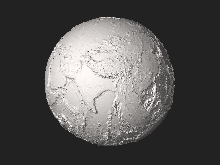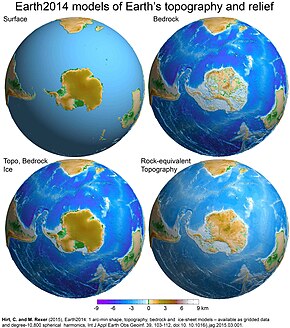279:(California). The version 15_PLUS comes at 0.25 arc-min resolution (about 450 m postings), while the 30_PLUS version offers 0.5 arc-min (900 m) resolution. The bathymetric data in SRTM30_PLUS stems from depth soundings (SONAR) and from satellite altimetry. The bathymetric component of SRTM30_PLUS gets regularly updated with new or improved data sets in order to continuously improve and refine the description of the sea floor geometry. Over land areas, SRTM30 data from the USGS is included. SRTM30_PLUS provides background information for
248:
25:
213:
65:
56:
189:
about 1.8 km postings). Some products such as the 30 and 15 arc-second resolution SRTM30_PLUS/ SRTM15_PLUS grids offer higher resolution to adequately represent SONAR depth measurements where available. Although grid cells are spaced at 15 or 30 arc-seconds, when SONAR measurements are unavailable, the resolution is much worse (~20-12 km) depending on factors such as water depth.
188:
missions), the global bathymetry (e.g., SRTM30_PLUS) is known to a much lesser spatial resolution in the kilometre-range. The same holds true for models of the bedrock of
Antarctica and Greenland. Therefore, global relief models are often constructed at 1 arc-minute resolution (corresponding to
255:
The Earth2014 global relief model, developed at Curtin
University (Western Australia) and TU Munich (Germany). Earth2014 provides sets of 1 arc-min resolution global grids (about 1.8 km postings) of Earth's relief in different representations based on the 2013 releases of bedrock and ice-sheet data
259:
Earth2014 provides five different layers of height data, including Earth's surface (lower interface of the atmosphere), topography and bathymetry of the oceans and major lakes, topography, bathymetry and bedrock, ice-sheet thicknesses and rock-equivalent topography. The Earth2014 global grids are
307:
The ETOPO1 global relief model is based on the 2001 Bedmap1 model of bedrock over
Antarctica, which is now superseded by the significantly improved Bedmap2 bedrock data. The ETOPO1-contained information on ocean depths is superseded through several updates of the SRTM30_PLUS bathymetry.
303:
over the oceans and some of Earth's major lakes. ETOPO1 land topography and ocean bathymetry relies on SRTM30 topography and a multitude of bathymetric surveys that have been merged. Historic versions of ETOPO1 are the ETOPO2 and ETOPO5 relief models (2 and 5 arc-min resolution).
299:(Colorado), provides two layers of relief information. One layer represents the global relief including bedrock over Antarctica and Greenland, and another layer the global relief including ice surface heights. Both layers include
139:
techniques. This is because there is no single remote sensing technique that would allow measurement of the relief both over dry and water-covered areas. Elevation data over land is often obtained from
96:
model (DBM) data over water-covered areas (oceans, lakes) to describe Earth's relief. A relief model thus shows how Earth's surface would look like in the absence of water or ice masses.
251:
Four different topography layers of the Earth2014 model. Clockwise from top left: (1) Earth's surface, (2) bedrock, (3) rock-equivalent topography, (4) bathymetry and ice surface
185:
59:
Example of a global relief model: Earth2014 bedrock layer (topography over land, bathymetry over oceans and major lakes, sub-ice-topography over ice-shields)
256:
over
Antarctica (Bedmap2) and Greenland (Greenland Bedrock Topography), the 2013 SRTM_30PLUS bathymetry and 2008 SRTM V4.1 SRTM land topography.
352:"Earth2014: 1 arc-min shape, topography, bedrock and ice-sheet models - available as gridded data and degree-10,800 spherical harmonics"
205:
The 2022 ETOPO version is the most recent global relief model with several scans at 1 arc-min, 30 arc-sec, and 15 arc-sec resolutions.
145:
407:
Sandwell, D.; et al. (2014). "New global marine gravity model from CryoSat-2 and Jason-1 reveals buried tectonic structure".
99:
The relief is represented by a set of heights (elevations or depths) that refer to some height reference surface, often the mean
267:
for the conventional relief model, and as planetary radii relative to the centre of Earth to show the shape of the Earth.
276:
180:
While digital elevation models describe Earth's land topography often with 1 to 3 arc-second resolution (e.g., from the
519:
458:
Amante, C.; Eakins, B.W. (2009). "ETOPO1 1 Arc-Minute Global Relief Model: Procedures, Data
Sources and Analysis".
296:
181:
509:
351:
223:
89:
484:
325:
514:
416:
366:
8:
197:
Data sets produced and released to the public include Earth2014, SRTM30_PLUS and ETOPO1.
124:
420:
370:
156:
and altimetry. Global relief models may also contain elevations of the bedrock (sub-ice-
38:
Please help update this article to reflect recent events or newly available information.
440:
432:
247:
69:
444:
463:
424:
382:
374:
108:
489:
135:
Global relief models are always based on combinations of data sets from different
264:
136:
386:
378:
503:
116:
428:
436:
280:
72:
of Earth without liquid water but with ice, with 20× elevation exaggeration
284:
212:
107:. Global relief models are used for a variety of applications including
55:
494:
300:
161:
157:
149:
120:
93:
275:
SRTM30_PLUS is a combined bathymetry and topography model produced by
64:
467:
359:
International
Journal of Applied Earth Observation and Geoinformation
165:
100:
172:, is subtracted from the ice surface heights to reveal the bedrock.
112:
16:
Model of Earth's relief including elevation and depth underwater
168:. Ice sheet thickness, mostly measured through ice-penetrating
261:
169:
153:
141:
104:
295:
The ETOPO1 1-arcmin global relief model, produced by the
330:
National
Centers for Environmental Information (NCEI)
501:
451:
457:
343:
400:
349:
460:NOAA Technical Memorandum NESDIS NGDC-24
406:
246:
62:
54:
502:
270:
175:
127:modelling as well as geo-statistics.
260:provided as heights relative to the
207:
18:
277:Scripps Institution of Oceanography
242:
192:
13:
92:(DEM) data over land with digital
14:
531:
478:
297:National Geophysical Data Center
290:
211:
23:
63:
318:
130:
1:
311:
200:
350:Hirt, C.; Rexer, M. (2015).
80:, sometimes also denoted as
7:
326:"ETOPO Global Relief Model"
160:) below the ice shields of
10:
536:
379:10.1016/j.jag.2015.03.001
32:This article needs to be
520:Digital elevation models
429:10.1126/science.1258213
90:digital elevation model
82:global topography model
252:
220:This section is empty.
73:
60:
510:Topography techniques
250:
152:is acquired based on
68:
58:
490:SRTM30 Plus homepage
148:measurements, while
421:2014Sci...346...65S
371:2015IJAEO..39..103H
78:global relief model
485:Earth2014 homepage
387:20.500.11937/25468
271:SRTM30_PLUS (2014)
253:
176:Spatial resolution
74:
61:
240:
239:
53:
52:
527:
472:
471:
468:10.7289/V5C8276M
455:
449:
448:
404:
398:
397:
395:
393:
356:
347:
341:
340:
338:
337:
322:
243:Earth2014 (2015)
235:
232:
222:You can help by
215:
208:
193:Public data sets
109:geovisualization
67:
48:
45:
39:
27:
26:
19:
535:
534:
530:
529:
528:
526:
525:
524:
500:
499:
495:ETOPO1 homepage
481:
476:
475:
456:
452:
415:(6205): 65–67.
405:
401:
391:
389:
354:
348:
344:
335:
333:
324:
323:
319:
314:
293:
273:
245:
236:
230:
227:
203:
195:
178:
133:
86:composite model
49:
43:
40:
37:
28:
24:
17:
12:
11:
5:
533:
523:
522:
517:
512:
498:
497:
492:
487:
480:
479:External links
477:
474:
473:
450:
399:
342:
316:
315:
313:
310:
292:
289:
272:
269:
265:mean sea level
244:
241:
238:
237:
218:
216:
202:
199:
194:
191:
177:
174:
137:remote sensing
132:
129:
117:geomorphologic
51:
50:
31:
29:
22:
15:
9:
6:
4:
3:
2:
532:
521:
518:
516:
513:
511:
508:
507:
505:
496:
493:
491:
488:
486:
483:
482:
469:
465:
461:
454:
446:
442:
438:
434:
430:
426:
422:
418:
414:
410:
403:
388:
384:
380:
376:
372:
368:
364:
360:
353:
346:
331:
327:
321:
317:
309:
305:
302:
298:
291:ETOPO1 (2009)
288:
286:
282:
278:
268:
266:
263:
257:
249:
234:
231:December 2022
225:
221:
217:
214:
210:
209:
206:
198:
190:
187:
183:
173:
171:
167:
163:
159:
155:
151:
147:
143:
138:
128:
126:
125:gravity field
122:
118:
114:
110:
106:
102:
97:
95:
91:
87:
83:
79:
71:
66:
57:
47:
44:November 2022
35:
30:
21:
20:
459:
453:
412:
408:
402:
392:February 20,
390:. Retrieved
362:
358:
345:
334:. Retrieved
332:. 2020-08-19
329:
320:
306:
294:
281:Google Earth
274:
258:
254:
228:
224:adding to it
219:
204:
196:
179:
134:
98:
85:
81:
77:
75:
70:STL 3D model
41:
33:
515:Cartography
365:: 103–112.
285:Google Maps
131:Measurement
121:geophysical
88:, combines
504:Categories
336:2023-08-11
312:References
301:bathymetry
201:ETOPO 2022
162:Antarctica
158:topography
150:bathymetry
123:analyses,
94:bathymetry
166:Greenland
101:sea level
445:31851740
437:25278606
113:geologic
417:Bibcode
409:Science
367:Bibcode
103:or the
34:updated
443:
435:
441:S2CID
355:(PDF)
262:EGM96
186:ASTER
170:RADAR
154:SONAR
146:inSAR
142:LIDAR
105:geoid
433:PMID
394:2016
283:and
182:SRTM
164:and
119:and
464:doi
425:doi
413:346
383:hdl
375:doi
226:.
184:or
144:or
84:or
506::
462:.
439:.
431:.
423:.
411:.
381:.
373:.
363:39
361:.
357:.
328:.
287:.
115:,
111:,
76:A
470:.
466::
447:.
427::
419::
396:.
385::
377::
369::
339:.
233:)
229:(
46:)
42:(
36:.
Text is available under the Creative Commons Attribution-ShareAlike License. Additional terms may apply.


